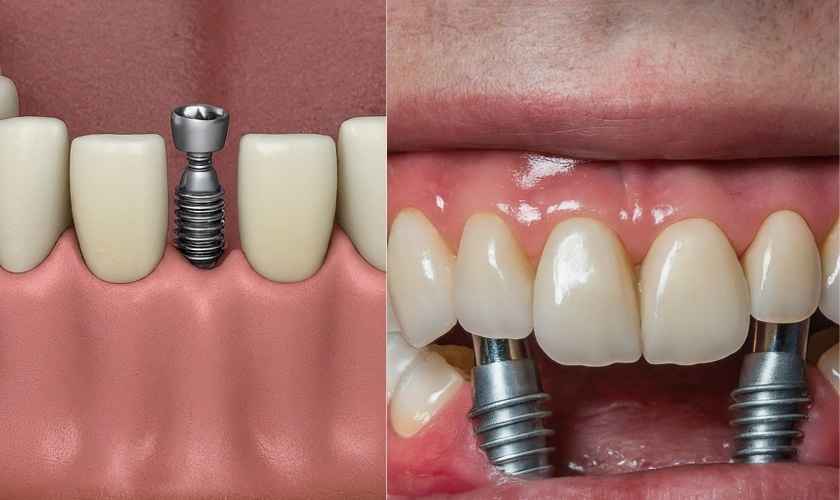Fascination About Dental Sense
Fascination About Dental Sense
Blog Article
Facts About Dental Sense Uncovered
Table of ContentsThe Only Guide for Dental SenseThe Best Strategy To Use For Dental SenseDental Sense for BeginnersEverything about Dental Sense
are clinical devices operatively implanted into the jaw to bring back a person's capability to chew or their appearance. They give assistance for artificial (phony) teeth, such as crowns, bridges, or dentures. When a tooth is lost because of injury or illness, an individual can experience complications such as rapid bone loss, defective speech, or modifications to eating patterns that result in pain.Dental dental implant systems include an oral implant body and oral implant joint and might also consist of an abutment fixation screw. Dental implants. The oral implant body is operatively put in the jawbone instead of the tooth's origin. The oral implant abutment is normally affixed to the dental implant body by the abutment addiction screw and prolongs with gums right into the mouth to support the connected synthetic teeth
(https://pastebin.com/u/dentalsense1)Structure of The Dental Implant System picking dental implants, talk with your oral supplier about the potential advantages and threats, and whether you are a candidate for the procedure. Points to take into consideration: Your overall wellness is an essential element in establishing whether you are a good prospect for dental implants, how much time it will take to heal, and the length of time the implant might remain in area.
Smoking cigarettes might influence the recovery procedure and lower the long-lasting success of the dental implant. The recovery process for the dental implant body may take numerous months or longer, during which time you typically have a short-term joint instead of the tooth. the oral implant treatment: Carefully follow the dental hygiene guidelines given to you by your oral supplier.
Facts About Dental Sense Revealed
Implant failing can cause the need for another medical procedure to repair or replace the dental implant system. Recovers the capability to eat Restores aesthetic appearance Aids maintain the jawbone from shrinking as a result of bone loss Maintains the wellness of the surrounding bone and periodontals Helps keep adjacent (close-by) teeth steady Boosts lifestyle Damage to surrounding natural teeth throughout implant placement Injury to the surrounding cells throughout surgery, such as sinus opening Injury during surgical procedure (for example, fracture of bordering jawbone) Insufficient feature, such as feeling like the teeth do not attack with each other typically An experience that the tooth hangs or twisting in position resulting from an abutment screw loosening up Implant body failing (looseness of the dental implant body) due to systemic infection, which may be most likely in patients with unchecked diabetes mellitus because of local this website infection in bone and gums supporting the dental implant body as a result of postponed healing, which may be more probable in clients who smoke Difficulty cleaning the gums around the dental implant, causing bad dental hygiene Neglected periodontal disease Post-surgical pins and needles as a result of nerve impingement or damages Constantly alert healthcare suppliers and imaging service technicians that you have dental implants before any type of magnetic resonance imaging (MRI) or x-ray treatments.
FDA is not knowledgeable about any type of damaging events reported for MRI or x-ray treatments with dental implants. Oral implants systems are usually made of products that adhere to worldwide agreement requirements of the International Company for Standardization (ISO) or ASTM International. These requirements have information of what makes a risk-free product.

A dental implant is a framework that changes a missing out on tooth. With screw-like gadgets, the specialist inserts an implant into the jawbone, and it acts as an anchor for a synthetic tooth, called a crown.
Excitement About Dental Sense
Some people are not eligible for oral implant surgical procedure. It is for oral surgeons to operate on individuals with: severe illnessuncontrollable metabolic diseasebone or soft cells illness or infectionIf these issues are resolved, an individual can have the surgery. In, oral surgeons avoid operating people with: If people with any of the above undertake dental implant surgical procedure, there is a greater danger of the dental implant falling short.

Oral dental implant surgical treatment is a tailored process. It's not the exact same for everyone. The complying with gives a general introduction of what you can anticipate your dental expert, dental doctor, periodontist or prosthodontist to do: Position the dental implant operatively. Give you time to recover. Affix the blog post and final crown, bridge or denture.
Next, your doctor will thoroughly position the oral implant into your jaw. Your doctor will rearrange your periodontals and close the cut with stitches. If your dental implant is near the front of your mouth, your dental practitioner will certainly make a short-term tooth for you to put on until you heal. That way, you will not have a void in your smile while you recuperate.
Some Known Incorrect Statements About Dental Sense
Your provider can tell you what to expect in your scenario. During the healing phase, your jawbone should fuse to the oral implant. This process, called osseointegration, is crucial for security and long-lasting success. This procedure can take anywhere from 3 to nine months. Sometimes, it may take much longer.
Once your implant heals, your dental professional can attach the abutment (small adapter article) and your final remediation (crown, bridge or denture). This generally takes concerning one hour to complete and may need a second minor surgery. You should not really feel any kind of pain throughout your oral implant treatment due to the fact that your service provider will make use of drug to numb your gums.
Report this page